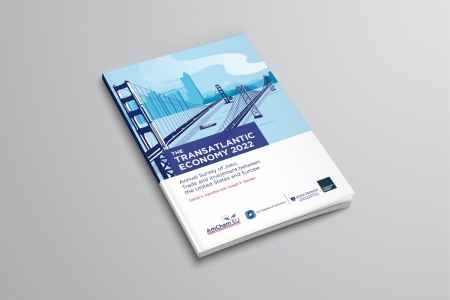The Transatlantic Economy 2021 report demonstrates the fundamental importance of the two sides of the Atlantic for the global economy. Even with the hit from the coronavirus and much talk of de-globalisation, the United States and Europe remain deeply intertwined. Consumers and producers, workers and companies, citizens, and their governments on both sides of the Atlantic directly benefit from the deep integrative forces that bind the United States and Europe together.
The US: Still the EU’s biggest trade partner
Amid reports that China has overtaken the US as Europe’s most important trading partner, it bears repeating that a trade relationship counts for more than trade in tangible goods. While it is true that China’s trade in goods with the EU stood at €568 billion in 2020, versus the US’ €555 billion goods trade with the EU, this is just one metric of a trade relationship. When adding trade in services to the picture, the EU-US trade relationship jumps to €950 billion in 2020, versus EU-China total trade of €657 billion. However, in today’s deeply interconnected global economy, trade flows barely scratch the surface of the deep transatlantic economic ties.
How to measure the transatlantic partnership?
It is investment and the activities of foreign affiliates, not trade, that drives U.S.- European commerce. The largest commercial relationship in the world stretches across the Atlantic. Total transatlantic foreign affiliate sales were estimated at $6.2 trillion in 2019, easily ranking as the top commercial artery in the world on account of the thick investment ties between the two parties.
When accounting for gross product of foreign affiliates; assets of foreign affiliates; affiliate employment; research and development spending of foreign affiliates; intra-firm trade of foreign affiliates; foreign affiliate sales; foreign affiliate profits; and transatlantic services trade, there can be no doubt as to the significance of the transatlantic partnership to the global economy. As the report’s authors write: US and European commercial ties with each other are like a 12-lane Autobahn.
Stat-attack
- US and European exports taken together account for 27% of global exports. US and European imports represent 32% of the world total. By comparison, the regions accounted for 61% of inward FDI stock and 64% of outward FDI stock.
- The combined output of transatlantic foreign affiliates of over $1.4 trillion is more than the output of the countries of Australia, Spain and Mexico.
- US foreign affiliates directly employ 4.9 million workers in Europe. European affiliates in the United States directly employ 5 million workers.
- US affiliates spend $33 billion on research and development in Europe. That is 56% of all R&D spending abroad by US companies. European affiliates in the US spend $45 billion on R&D.
- Intra-firm trade makes up the majority of US-EU trade flows: 63% of US imports from Europe came from European affiliates of US companies.
- Affiliate sales, not exports, are the primary means by which US firms deliver goods and services to global customers. Foreign affiliates of US firms made sales of $7 trillion across the globe in 2019. Europe accounted for 50% of these sales – making Europe the biggest customer of US affiliates.
- US services exports to Europe reached a record $345 billion in 2019.



